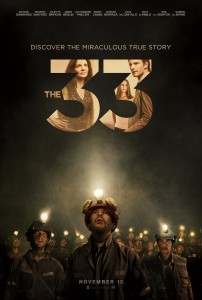Patricia Riggen’s The 33 takes a real-life story–a near-disaster in 2010–and turns into a conventional social problem picture.
Despite some strong powerful moments, the movie unfolds as a rather routine tale due to the weak and shallow scenario.
The film is based on well-known and well-documented events: The August 5, 2010 Chilean disaster, which left thirty-three miners trapped underground for sixty-nine days in the San Jose gold Mine in Chile’s Atacama Desert.
Five years ago, the whole world watched on TV as the survivors were lifted, one man at a time, from a capsule lowered 2,300 feet below the surface.
As a real-time TV event, it was riveting, inspirational, and stirring, due to the victorious ending, which culminated the fight over all kinds of obstacles, some political, other technical, and still other human, though the bravery and unusual survival skills of the minder were never in question.
Based on Hector Tobar’s book “Deep Down Dark,” “The 33″ credits three writers, so it’s impossible to attribute. As it is, the movie unfolds as a catalogue of efforts, conducted both above ground and underground, by a dozen characters that, unfortunately are narrowly constructed as types and even stereotypes.
Some critics and viewers may oppose to the lack of authenticity in the casting of non-Chilean actors, Spanish-American Antonio Banderas as the miners’ leader, French star Juliette Binoche (in deglamorized form) as the older sister of a young and alienated trapped miner, all-American James Brolin, Irish-born Gabriel Byrne, and others.
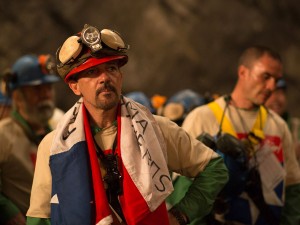 Director Riggen (“Girl in Progress”) and her scribes (Mikko Alanne, Craig Borten, Michael Thomas) seem less interested in the individual personalities of the miners and the specific nature of their conflicts as they offer superficial sketches of both. By necessity, they have reduced the number of protagonists to ten and have chosen to present composites that loosely incorporate factual attributes.
Director Riggen (“Girl in Progress”) and her scribes (Mikko Alanne, Craig Borten, Michael Thomas) seem less interested in the individual personalities of the miners and the specific nature of their conflicts as they offer superficial sketches of both. By necessity, they have reduced the number of protagonists to ten and have chosen to present composites that loosely incorporate factual attributes.
The story begins during a retirement party in Copiapo, Chile, in which the grizzled honoree has only days left in the gold-copper mine. He is contrasted with another miner (Mario Casas), a skilled mechanic who begs for extra work because his wife Jessica is expecting soon–she is six-month pregnant–and he wants to give them a better life, despite the objections of his father who doesn’t want him to work in the mine.
The party introduces briefly the other ill-fated laborers, each given one definable attribute or distinct problem. Thus, Edison Pena (Jacob Vargas) is an Elvis impersonator; Yonni Barrios (Oscar Nunez), is involved in a love triangle; Luis Urzua (Lou Diamond Phillips), who the men call “Don Lucho,” is the only one who shows real concern for the mine’s safety issues. But though he has already warned his superiors, he himself is unprepared for the proportions of the oncoming disaster.
There is no lack of on screen characters, which could have been far more interesting and engaging than they are. Later on, we meet Dario Segovia (Juan Pablo Raba), an addict who’s estranged from his steadfast older sister, Maria (Juliette Binoche), and Carlos Mamani (Tenoch Huerta), a Bolivian newcomer who attracts suspicion from the group.
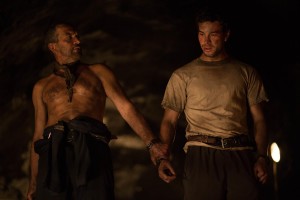 After the 121-year-old mine collapses, it shifts the 33 men deep underground to a small and dark area, called “the Refuge.” Some of the film’s more interesting sections depict the emergence of Mario Sepulveda (Banderas), aka “Super Mario,” a spirited leader who keeps them united in a claustrophobic setting and under desperate circumstances. A natural born organizer, Mario is literally given the key to their survival, the food locker. Despite rising tensions, Super Mario works hard to stretch the supply of food and water of three days to many weeks.
After the 121-year-old mine collapses, it shifts the 33 men deep underground to a small and dark area, called “the Refuge.” Some of the film’s more interesting sections depict the emergence of Mario Sepulveda (Banderas), aka “Super Mario,” a spirited leader who keeps them united in a claustrophobic setting and under desperate circumstances. A natural born organizer, Mario is literally given the key to their survival, the food locker. Despite rising tensions, Super Mario works hard to stretch the supply of food and water of three days to many weeks.
Meanwhile, the rescue effort hits an immediate snag when the mining company fails to act and the Chilean government takes over at great political risks. Laurence Golborne (Rodrigo Santoro), the Mines Minister, tries to assert himself as the determined yet diplomatic politico, who is forced to work closely with Andre Sougarret (Gabriel Byrne), the chief engineer who’s considered to be brilliant, though at a certain point, he, too, almost gives up.
The film gets better in its second half, which depicts the overcoming of various obstacles, the ominous cracks in the mountain wall that finally giving way, a near-miss attempt that almost spells the miners’ doom, an international effort to drill a hole large enough to get the capsule down, and bets of all, the suspense involved when the first miner inches through the brittle rock.
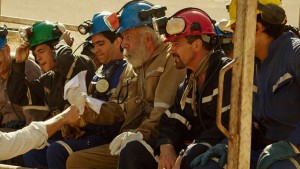 The main problems of “The 33” is the lack of POV, the absence of a specific angle on the ordeal, the missing of a guiding director able to distinguish the important from the less significant events, resulting in a film that is like a survey of events and characters.
The main problems of “The 33” is the lack of POV, the absence of a specific angle on the ordeal, the missing of a guiding director able to distinguish the important from the less significant events, resulting in a film that is like a survey of events and characters.
Along the way, hints are given of the role of political factors–the manipulative calculations of the government and its charismatic president–in dealing with the crisis.
Periodically, the tale depicts vividly the new community that evolves within “Camp Hope,” the makeshift tent city for the miners’ wives and children, who insists on staying on until definitive information is provided and the crisis is resolved. There is one funny moment in which a miner’s legit wife and mistress fight ferociously, only to reconcile and hug when they find out he is safe.
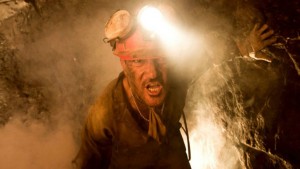 While the acting (and accents) of the international ensemble is uneven, the physical production and on location shooting are commendable. Checco Varese’s images exploit Chile’s remote yet breathtakingly beautiful Atacame Desert (just a few kilometers away from where the actual event took place) and the interiors of two mines in Central Colombia. The musical score, by the late James Horner, is at times overbearing, as if trying to compensate for the dramatic shortcomings.
While the acting (and accents) of the international ensemble is uneven, the physical production and on location shooting are commendable. Checco Varese’s images exploit Chile’s remote yet breathtakingly beautiful Atacame Desert (just a few kilometers away from where the actual event took place) and the interiors of two mines in Central Colombia. The musical score, by the late James Horner, is at times overbearing, as if trying to compensate for the dramatic shortcomings.
